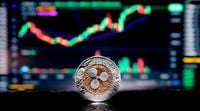On July 14, 2025, XRP surged to its highest levels in months, sparking renewed excitement among investors and analysts alike about the cryptocurrency's potential to reshape global finance. The digital asset climbed nearly 6% to reach an intraday high of $2.98, marking its strongest performance since March and pushing it through a critical resistance level at $2.84. This rally has been driven by a combination of institutional interest, technical breakthroughs, and strategic partnerships that position XRP as more than just a speculative token.
Tomoya Asakura, CEO of SBI Global Asset Management, made headlines by declaring XRP a transformative force in wealth transfer for the current generation. Asakura emphasized XRP's growing adoption by financial institutions, particularly in Japan, where many banks are expected to integrate the cryptocurrency in the coming years. He highlighted XRP's utility in enabling fast, affordable cross-border payments, a feature that sets it apart from many other digital assets.
Asakura also pointed to Ripple’s recent partnership with a global banking giant that will serve as custodian for Ripple’s stablecoin, RLUSD. This strategic alliance combines the stablecoin with XRP’s liquidity token, creating a foundation for next-generation cross-border payment solutions. He believes this synergy, backed by trusted banking infrastructure, could revolutionize global payment systems and accelerate XRP’s adoption worldwide.
Another major catalyst for XRP’s growth is Ripple’s pursuit of a U.S. banking license. If granted, this would enable Ripple to operate as a federally regulated trust bank, deepening institutional involvement and legitimizing XRP’s role in the financial sector. SBI Group, which owns a 9% stake in Ripple and is its largest external shareholder, has been instrumental in driving XRP adoption across Asia through platforms like SBI VC Trade and SBI Remit. SBI’s initiatives, such as allowing users to convert credit card reward points into XRP, aim to mainstream digital assets in everyday finance.
The technical picture for XRP is equally compelling. The token has broken past key resistance levels, including $2.60 and the critical $2.84 mark, and is holding above all major exponential moving averages. Trading volume has soared, with Coinglass reporting open interest climbing to $7.2 billion and whales reportedly holding $3.8 billion worth of XRP. The relative strength index (RSI) is in overbought territory at 81.05, signaling strong bullish momentum.
Analysts are eyeing price targets that indicate significant upside potential. A bullish pennant pattern, formed between December and July, suggests a profit target of $6.27 based on technical analysis. Some experts predict that XRP could reach $10 this year, which would represent a 233% surge from current levels and push its market capitalization to approximately $559 billion. This is considered reasonable given that Bitcoin and Ethereum currently hold market caps of over $2.35 trillion and $360 billion, respectively.
Market watchers like pseudonymous analyst Pentoshi, who boasts over 870,000 followers, have suggested that XRP could embark on a new price discovery phase within weeks, potentially breaking above its previous all-time high near $3.40. Another analyst, Alex Cobb, has forecasted an even more ambitious target, predicting XRP could reach $4.35 by the end of July, representing a nearly 79% gain from current prices.
Institutional validation has played a pivotal role in this resurgence. Grayscale recently added XRP to its Digital Large Cap Fund for the first time since regulatory restrictions were lifted, signaling growing acceptance among major investors. Additionally, ten XRP spot exchange-traded fund (ETF) applications are pending with U.S. regulators, with decisions expected as early as October. The potential approval of an XRP ETF could drive further inflows, mirroring the success of spot Bitcoin ETFs, which have attracted over $52 billion, and Ethereum ETFs, which recently crossed $5 billion in assets.
The regulatory environment is also shifting favorably. The Securities and Exchange Commission (SEC) has confirmed that XRP is not classified as a security, removing a significant hurdle for institutional adoption. Furthermore, the proposed GENIUS Act aims to regulate stablecoins, a category that includes Ripple’s RLUSD but currently excludes competitors like Tether (USDT). This regulatory clarity could prompt users to migrate toward regulated stablecoins such as RLUSD, further bolstering XRP’s ecosystem.
XRP’s recent price surge has helped it reclaim its position as the third-largest cryptocurrency by market capitalization, with a market value swelling by $30 billion over the past week alone. The rally has coincided with a broader bullish trend in the crypto market, fueled by Bitcoin surpassing $120,000 and forecasts suggesting it could reach $200,000 by year-end. Ethereum has also surged above $3,000, its highest level since January, while altcoins like Dogecoin have gained momentum.
While XRP is capturing headlines with its impressive comeback, another cryptocurrency, Remittix (RTX), is quietly making strides in the global remittance market. With over $16 million raised and 550 million tokens sold, Remittix is leveraging its PayFi protocol to enable seamless crypto-to-fiat payments across borders, targeting the $250 trillion global remittance industry. Early investors have seen gains of around 400% in 2025, highlighting the growing appetite for practical crypto solutions beyond the headline-grabbing tokens.
In summary, XRP’s blend of strong institutional backing, technical strength, regulatory progress, and real-world utility is positioning it as a key driver of financial transformation. With strategic partnerships like Ripple’s collaboration with a global banking giant, the potential U.S. banking license, and growing ETF interest, XRP is evolving from a speculative asset into a foundational element of the future global financial system. Whether it can hit ambitious price targets like $10 or even $35 remains to be seen, but the momentum and fundamentals suggest the digital asset is far from finished making waves.





